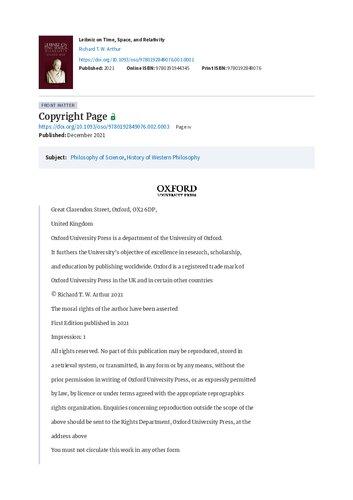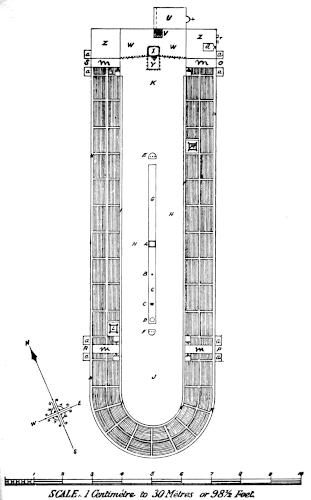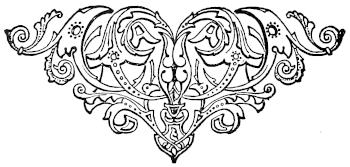Discovering Diverse Content Through Random Scribd Documents
PLAN OF THE HIPPODROME. FROM GROSVENOR’S “CONSTANTINOPLE ”
In the middle of the arena stood the spina, a marble wall, four feet high and six hundred feet long, with the Goal of the Blues at the northern end facing the throne, and that of the Greens facing the sphendone. The spina was decorated with the choicest statuary, including the three surviving monuments. Of these the Egyptian obelisk, belonging to the reign of Thotmes III., had already stood for more centuries in Egypt than have elapsed since Constantine
transported it to his new capital. When it arrived, the engineers could not raise it into position and it remained prone until, in 381, one Proclus, a præfect of the city, succeeded in erecting it upon copper cubes. The shattered column belongs to a much later epoch than that of Constantine. It was set up by Constantine VIII. Porphyrogenitus, and once glittered in the sun, for it was covered with plates of burnished brass. The third, and by far the most interesting monument of the three, is the famous column of twisted serpents from Delphi. Its romantic history never grows dull by repetition. For this is that serpent column of Corinthian brass which was dedicated to Apollo by the thankful and exultant Greeks after the battle of Platæa, when the hosts of the Persian Xerxes were thrust back from the soil of Greece never to return. It bears upon its coils the names of the thirty-one Greek cities which fought for freedom, and there is still to be seen, inscribed in slightly larger characters than the rest, the name of the Tenians, who, as Herodotus tells us, succeeded in proving to the satisfaction of their sister states that they deserved inclusion in so honourable a memorial. The history of this column from the fifth century before the Christian era down to the present time is to be read in a long succession of Greek, Roman, mediæval, and modern historians; and as late as the beginning of the eighteenth century the three heads of the serpents were still in their place. But even in its mutilated state there is perhaps no relic of antiquity which can vie in interest with this column, associated as it was in the day of its fashioning with Pausanias and Themistocles, with Xerxes and with Mardonius. We have then to think of it standing for seven centuries in the holiest place of all Hellas, the shrine of Apollo at Delphi. There it was surmounted by a golden tripod, on which sat the priestess who uttered the oracles which, in important crises, prompted the policy and guided the development of the cities of Greece. The column is hollow, and it is possible that the mephitic exhalations, which are supposed to have stupefied the priestess when she was possessed by the god, mounted up the interior of the spiral. The golden tripod was stolen during the wars with Philip of Macedon; Constantine replaced it by another when he brought the column from Delphi to Constantinople. And there, surviving all the vicissitudes through which the city has passed, still stands the
column, still fixed to the pedestal upon which Constantine mounted it, many feet below the present level of the Atmeidan, still an object of superstition to Christian as well as to the Turk, and owing, no doubt, its marvellous preservation to the indefinable awe which clings, even in ruin, to the sacred relics of a discredited religion.
THE SERPENT OF DELPHI. FROM GROSVENOR’S “CONSTANTINOPLE.”
To the Hippodrome itself there were four principal entrances. The gate of the Blues was close by the Carceres or Mangana, on the western side, with the gate of the Greens facing it. At the other end, just where the long straight line was broken and the building began to curve into the sphendone, was a gate on the eastern side which bore the ill-omened name of the Gate of the Dead, opposite another, the name of which is not known. The gate of the Blues—the royal faction—was the grand entrance for all state processions.
Such was the outward form of the famous Hippodrome, and Mr Grosvenor justly dwells on the imposing vastness and beauty of its external appearance.
“The walls were of brick, laid in arches and faced by a row of Corinthian pillars. What confronted the spectator’s eye was a wall in superposed and continuous arches, seen through an endless colonnade. Seventeen columns were still erect upon their bases in 1529. Gyllius, who saw them, says that their diameter was three and eleven-twelfths feet. Each was twenty-eight feet high, and pedestal and capital added seven feet more. They stood eleven feet apart. Hence, deducting for the gates, towers, and palace, at least two hundred and sixty columns would be required in the circuit. If one, with the curiosity of a traveller, wished to journey round the entire perimeter, he must continue on through a distance of three thousand and fifteen feet, before his pilgrimage ended at the spot where it had begun; and ever, as he toiled along, there loomed into the air that prodigious mass, forty feet above his head. No wonder that there remained, even in the time of the Sultan Souleiman, enough to construct that most superb of mosques, the Souleimanieh, from the fallen columns, the splintered marbles, the brick and stone of the Hippodrome.”
But it was not merely the shell of the Hippodrome that was imposing by reason of its size and magnificence. It was filled with the choicest art treasures of the ancient world. Constantine stole masterpieces with the catholicity of taste, the excellence of artistic judgment, and the callous indifference to the rights of ownership which characterised Napoleon. He stripped the world naked of its treasures, as St. Jerome neatly remarked.[121] Rome and its conquering proconsuls and proprætors had done the same. Constantine now robbed Rome and took whatever Rome had left. Greece was still a fruitful quarry. We have already spoken of the Serpent Column, which was torn from Delphi. The historians have preserved for us the names of a number of other famous works of art which adorned the spina and the promenade of the Hippodrome. There was a Brazen Eagle, clutching a withing snake in its talons
and rising in the air with wings outspread; the Hercules of Lysippus, of a size so heroic that it measured six feet from the foot to the knee; the Brazen Ass and its driver, a mere copy of which Augustus had offered to his own city of Nicopolis founded on the shores of Actium; the Poisoned Bull; the Angry Elephant; the gigantic figure of a woman holding in her hand a horse and its rider of life size; the Calydonian Boar; eight Sphinxes, and last, but by no means least, the Horses of Lysippus. These horses have a history with which no other specimens of equine statuary can compare. They first adorned a temple at Corinth. Taken to Rome by Memmius when he laid Corinth in ashes, they were placed before the Senate House. Nero removed them that they might grace his triumphal arch; Trajan, with juster excuse, did the same. Constantine had them sent to Constantinople. Then, after nearly nine centuries had passed, they were again packed up and transported back to Italy. The aged Dandolo had claimed them as part of his share of the booty and sent them to Venice. There they remained for almost six centuries more until Napoleon cast covetous eyes upon them and had them taken to Paris to adorn his Arc de Triomphe. On his downfall Paris was compelled to restore them to Venice and the horses of Lysippus paw the air once more above the roof of St. Mark’s Cathedral.
We have thus briefly enumerated the most magnificent public buildings with which Constantine adorned his new capital, and the choicest works of art with which these were further embellished. The Emperor pressed on the work with extraordinary activity. No one believes the story of Codinus that only nine months elapsed between the laying of the first stone and the formal dedication which took place in the Hippodrome on May 11th, 330, but it is only less wonderful that so much should have been done in four years. The same untrustworthy author also tells a strange story of how Constantine took advantage of the absence of some of his officers on public business to build exact models of their Roman mansions in Constantinople, and transport all their household belongings, families, and households to be ready for them on their return as a pleasant surprise. What is beyond doubt is that the Emperor did offer the very greatest inducements to the leading men of Rome to leave Rome for good and make Constantinople their home. He even
published an edict that no one dwelling in Asia Minor should be allowed to enter the Imperial service unless he built himself a house in Constantinople. Peter the Great issued a like order when he founded St. Petersburg and opened a window looking on Europe. The Emperor changed the destination of the corn ships of Egypt from Rome to Constantinople, established a lavish system of distributions of wheat and oil and even of money and wine, and created at the cost of the treasury an idle and corrupt proletariate. He thus transported to his new capital all the luxuries and vices of the old.
CHAPTER XIV
ARIUS AND ATHANASIUS
We have seen how, at the conclusion of the Council of Nicæa, it looked as if the Church had entered into her rest. The day of persecution was over; Christianity had found in the Emperor an ardent and impetuous champion; a creed had been framed which seemed to establish upon a sure foundation the deepest mysteries of the faith; heresy not only lay under anathema, but had been reduced to silence. Throughout the East—the West had remained practically untroubled—the feeling was one of confidence and joy. Constantine rejoiced as though he had won a personal victory; his subjects, we are told,[122] thought the kingdom of Christ had already begun. When Gregory, the Illuminator of Armenia, met his son, Aristaces, returning from Nicæa and heard from his lips the text of the new creed, he at once exclaimed: “Yea, we glorify Him who was before the ages, by adoring the Holy Trinity and the one Godhead of the Father, and of the Son and of the Holy Ghost, now and for ever, through ages and ages.”
Moreover, the Emperor’s violent edicts against the Arians, and the banishment of Eusebius and Theognis, all indicated a settled and rooted conviction which nothing could shake, while the death of the Patriarch Alexander of Alexandria and the election of Athanasius in his stead must have strengthened enormously the Catholic party in Egypt and, indeed, throughout the East. Alexander had died within a few months of his return from Nicæa, in the early part of 326. He is said, when on his death-bed, to have foretold the elevation of Athanasius and the trials which lay before him. He had called for Athanasius—who at the moment was away from Egypt—and another Athanasius, who was present in the room, answered for the
absent one. The dying man, however, was not deceived and said: “Athanasius, you think you have escaped, but you will not; you cannot.” We need not recount the stories which the malignity of his enemies invented in order to cast discredit upon Athanasius’ election. There is no reason to doubt either its validity or its overwhelming popularity in Alexandria, where, while the Egyptian bishops were in session, the Catholics outside the building kept up the unceasing cry: “Give us Athanasius, the good, the holy, the ascetic.” The election was not unanimous. Evidently some thought the situation required a conciliatory demeanour towards the beaten Arians. But that was not the view of the majority, who, by choosing Athanasius, set the best fighting man on their side upon the throne of St. Mark. They did wisely. Tolerance was not properly understood in the fourth century.
The outward peace lasted little more than two years. Unfortunately, we are almost entirely in the dark as to what took place during that time, beyond the certain fact of the recall of Arius, Eusebius, and Theognis. Arius had been banished to Galatia; then we read of the sentence being partially revoked, and the only embargo placed upon his freedom of movement was that he was forbidden to return to Alexandria. Did this take place before the recall of Eusebius and Theognis? Socrates gives the text of a strange letter written by these two prelates to the principal bishops of the Church, in which they definitely say that, inasmuch as Arius has been recalled from exile, they hope the bishops will use their influence with the Emperor on their behalf.
“After closely studying the question of the Homoousion,” they say, “we are wholly intent on preserving peace and we have been seduced by no heresy. We subscribed to the Creed, after suggesting what we thought best for the Church, but we refused to sign the anathema, not because we had any fault to find with the Creed, but because we did not consider Arius to be what he was represented as being. The letters we had received from him and the discourses we had heard him deliver compelled us to form a totally different estimate of his character.”
The authenticity of this letter has been sharply called in question, for there is no other scrap of evidence confirming the statement that Arius was recalled before Eusebius and Theognis—in itself a most improbable step. Constantine had issued an edict that any one concealing a copy of the writings of Arius and not instantly handing it over to the authorities to be burnt, should be put to death, and it is much more probable that Arius was recalled after, rather than before, Eusebius of Nicomedia. The “History” of Socrates contains many letters of doubtful authenticity and some which are, beyond dispute, forgeries. Among the latter we may certainly include the portentously long document in which Constantine is represented as making a grossly personal attack on the banished Arius. We will content ourselves with quoting the most vituperative passage:
“Look! Look all of you! See what wretched cries he utters, writhing in pain from the bite of the serpent’s tooth! See how his veins and flesh are poison-tainted and what agonised convulsions they excite! See how his body is wasted away with disease and squalor, with dirt and lamentation, with pallor and horror! See how he is withered up with a thousand evils! See how horrible to look upon is his filthy tangled head of hair; how he is half dead from top to toe; how languid is the aspect of his haggard, bloodless face; how madness, fury, and vanity, swooping down upon him together, have reduced him to what he is—a savage and wild beast! He does not even recognise the horrible situation he is in. ‘I am beside myself with joy’; he says, ‘I dance and leap with glee; I fly; I am a happy boy again.’”
ST. ATHANASIUS.
FROM THE BRITISH MUSEUM PRINT ROOM
Assuredly this raving production never came from the pen of Constantine, and it bears no resemblance to his ordinary style. The resounding platitude with which it opens, “An evil interpreter is really the image and counterpart of the Devil,” leads us confidently to acquit the Emperor of its authorship and ascribe it to some anonymous and unknown ecclesiastic desirous at once of edifying and terrifying the faithful.
We can only surmise the circumstances which worked upon the Emperor’s mind and caused his complete change of front with respect to Arianism and its exponents. Sozomen, indeed, attributes it wholly to the influence of his sister, Constantia. According to an Arian legend quoted by that historian, it was revealed to the Princess in “a vision from God” that it was the exiled bishops who held the true orthodox doctrine and, therefore, that they had been unjustly banished. She worked upon the impressionable mind of her brother, and the two bishops were recalled. When Constantine asked whether they still held the Nicene doctrines to which they had subscribed, they replied that they had assented, not from conviction, but from the fear lest the Emperor should be disgusted at the dissensions among the Christians, and revert to paganism. This curious story certainly tends to confirm the tradition that it was Constantia who was the court patroness of the Arians. She had been for years Empress in the palace of Nicomedia, and it is easy to suppose that the very able Bishop of that city had established a strong ascendency over her mind, long before the Arian controversy arose.
The upshot of the whole matter—however the change was brought about—was that in the year 329, the Arian and Eusebian party was paramount at the Imperial Court. They had persuaded the Emperor that theirs was the party of reason, and that those who persisted in troubling the peace of the Church by holding extreme views and seeking to impose rigorous tests were the followers of the new Patriarch of Alexandria. They had subscribed to the Nicene Creed or to a Creed which—so they persuaded the Emperor—was practically indistinguishable from it, and they now plotted, with great skill and adroitness, to undermine the position of Athanasius. How they conducted the intrigue we do not know, but it is significant that after the break up of the Council of Nicæa we hear no more, during Constantine’s lifetime, of his long-trusted adviser Hosius, Bishop of Cordova. The dreadful tragedies in the Imperial Family had taken place at Rome in the summer of 326. It is possible that Hosius made no secret of his horror at these monstrous crimes and retired to his Spanish bishopric, and that Eusebius of Nicomedia, when brought into communication with Constantine, was not so exacting in his
demand for a show of penitence and proved more skilful in allaying the Emperor’s remorse. Be that as it may, as soon as Eusebius felt assured of his position, he lost no time in prosecuting a vigorous campaign against those who had triumphed over him at Nicæa. The first blow was directed against Eustathius, the Bishop of Antioch, who was charged with heresy, profligacy, and tyranny by the two Eusebii and a number of other bishops, then on their way to Jerusalem. Whether the charges were well founded or not, the tribunal was a prejudiced one and the sentence of deprivation and banishment passed upon Eustathius was bitterly resented in Antioch. After certain other bishops had met with a like fate, the Eusebii flew at higher game and attacked Athanasius. They had already entered into an understanding with the Meletian faction in Egypt, who carefully kept alive the charges against Athanasius, and now they again took up the cudgels on behalf of Arius. Eusebius wrote to the Patriarch asking him to restore Arius to communion on the ground that he had been grievously misrepresented. Athanasius bluntly refused. Arius, he said, had started a deadly heresy: he had been anathematised by an Œcumenical Council: how, then, could he be restored to communion? Eusebius and Arius appealed to the Emperor. Constantine, who had previously ordered Arius to attend at court and promised him signal proof of his regard and permission to return to Alexandria, sent a peremptory message to Athanasius bidding him admit Arius. When Athanasius, on the score of conscience, returned a steady refusal, the Emperor angrily threatened that, if he did not throw open his church doors to all who desired to enter, he would send an officer to turn him out of his church and expel him from Alexandria. “Now that you have full knowledge of my will,” he added, “see that you provide uninterrupted entry to all who wish to enter the church. If I hear that you have prevented any one from joining the services, or have shut the doors in their faces, I will at once despatch some one to deport you from Alexandria.” The threat did not terrify Athanasius, who declared that there could be no fellowship between heretics and true believers. Nor was the Imperial officer sent. Then began an extraordinary campaign of calumny against the Patriarch, who was accused of taxing Egypt in order to buy a supply
of linen garments, called “sticharia,” for his church; of instigating one Macarius to upset a communion table and break a sacred chalice; of murdering a Meletian bishop named Arsenius, who was presently found alive and well; and of other crimes equally preposterous and unfounded. It was the Meletian irreconcilables in Egypt who brought these calumnies forward, but Athanasius had no doubt that the moving spirit was none other than Eusebius himself. And his enemies, whoever they were, were untiring and implacable. As soon as one calumny was refuted, they were ready with another, and all this time there was Eusebius at the Emperor’s side, continually suggesting that with so much smoke there needs must be some fire, and that Athanasius ought to be called upon to clear himself, lest the scandal should do injury to the Church. Constantine summoned a council to try Athanasius in 333, and fixed the place of meeting in Cæsarea,—a tolerably certain proof that the two Eusebii were acting in concert. For some reason not stated the bishops did not assemble until the following year, and then Athanasius refused to attend. Not until 335 did Athanasius stand before his episcopal judges at Tyre. Accompanied by some fifty of his suffragans, Athanasius had made the journey, only to find himself confronted by a packed council. All his bitterest enemies were there; all the old unsubstantiated charges were resuscitated. His election was said to be uncanonical; he was charged with personal unchastity and with cruelty towards certain Meletian bishops and priests; and, most curious of all, the ancient calumnies of “The Broken Chalice” and “The Dead Man’s Hand” were revived and pressed, as though they had never been confuted. With respect to the latter charge, Athanasius enjoyed one moment of signal triumph. After his accusers had caused a thrill of horror to pass through the Council by producing a blackened and withered hand, which they declared to belong to the missing Bishop Arsenius, who was supposed to have suffered foul play, Athanasius asked whether any of those present had known Arsenius personally A number of bishops claimed acquaintance, and then Athanasius gave the signal for a man, who was standing by closely muffled in a cloak, to come forward. “Lift up your head!” said Athanasius. The unknown did so, and lo! it was none other than Arsenius himself. Athanasius drew aside the cloak,
first from one hand and then from the other “Has God given to any man,” he asked quietly, “more hands than two?” His enemies were silenced, but only for the moment. One of them, cleverer than the rest, immediately exclaimed that this was mere sorcery and devil’s work; the man was not Arsenius; in fact, he was not even a man at all, but a mere counterfeit, an illusion of the senses produced by Athanasius’ horrible proficiency in the black art. And we are told that this ingenious explanation proved so convincing to the assembly, and created such a fury of resentment against Athanasius, that Dionysius, the Imperial officer who had been deputed by Constantine to represent him at the Council, had to hurry Athanasius on shipboard to save him from personal violence.
There was clearly so little corroborative evidence against Athanasius that the Council dared not convict him. But, as they were equally determined not to acquit him, they appointed a commission of enquiry to collect testimony on the spot in the Mareotis district of Egypt with respect to the story of the Broken Chalice. The six commissioners were chosen in secret session by the antiAthanasian faction. Athanasius protested without avail against the selection: they were all, he said, his private enemies. The commission sailed for Egypt, and Athanasius determined, with characteristic boldness, to go to Constantinople, confront the Emperor, and appeal for justice and a fair trial at the fountainhead. Athanasius met the Emperor as he was riding into the city, and stood before him in his path. What followed is best told by Constantine himself in a letter which he wrote to the Bishop of Tyre.[123] Here are his own words:
“As I was returning on horseback to the city which bears my name, Athanasius, the Bishop, presented himself so unexpectedly in the middle of the highway, with certain individuals who accompanied him, that I felt exceedingly surprised on beholding him. God, who sees all, is my witness that at first I did not know who he was, but some of my attendants, having ascertained this and the subject of his complaint, gave me the necessary information. I did not accord him an interview, but he persevered in requesting an audience, and, although I refused him and was on the point of ordering that he
should be removed from my presence, he told me, with greater boldness than he had previously manifested, that he sought no other favour of me than that I should summon you hither, in order that he might, in your presence, complain of the injustice that had been done to him.”
Such boldness had the success it deserved. Constantine evidently made enquires from Count Dionysius, and, discovering that the Council at Tyre was a mere travesty of justice, ordered the bishops to come forthwith to Constantinople. But before these instructions reached them they had received the report of the Egyptian commissioners, and, on the strength of it, had condemned Athanasius by a majority of votes, recognised the Meletians as orthodox, and, adjourning to Jerusalem for the dedication of the new church, had there pronounced Arius to be a true Catholic and in full communion with the Church. The Emperor’s letter, which began with a reference to the “tumults and disorders” which had marked their sessions, was a plain intimation that he disapproved of their proceedings, and only six bishops, the two Eusebii and four others, travelled up to Constantinople. Arrived there, they changed their tactics, and recognising that the old charges against Athanasius had fallen helplessly to the ground, they invented another which was much more likely to have weight with the Emperor. They accused him of seeking to prevent the Alexandrian corn ships from sailing to Constantinople. Egypt was the granary of the new Rome as well as of the old, and upon the regular arrival of the Egyptian wheat cargoes the tranquillity of Constantinople largely depended. Athanasius protested that he had entertained no such designs. He was, he said, simply a bishop of the Church, a poor man with no political ambition or taste for intrigue. His enemies retorted that he was not poor, but wealthy, and that he had gained a dangerous ascendency over the turbulent people of Alexandria. Constantine abruptly ended the dispute by banishing Athanasius to Treves, and the Patriarch had no choice but to obey. He arrived at his city of exile in 336, and was received with all honour by the Emperor’s son Constantine, then installed in the Gallic capital as the Cæsar of the West. This is tolerably certain proof that the Emperor did not regard
him as a very dangerous political opponent, but banished him rather for the sake of religious peace. Constantine was weary of such interminable disputations and such intractable disputants.
The exile of Athanasius was of course a signal victory for the Eusebians and for Arius. With the Patriarch of Alexandria thus safely out of the way, they might look forward with confidence to gaining the entire court over to their side and still further consolidating their position in the East. Arius returned in triumph to Alexandria, where he had not set foot for many years. But his presence was the signal for renewed popular disturbance. The Catholics remained faithful to their Bishop in exile—St. Antony repeatedly wrote to Constantine, praying for Athanasius’ recall—and Alexandria was in tumult. Constantine refused to reconsider the sentence of banishment on Athanasius, but he checked the violence of the Meletian schismatics by banishing John Arcaph from Alexandria, and he hurriedly recalled Arius to Constantinople. The heresiarch was summoned into the presence of the Emperor, who by this time was once more uneasy in his mind. Constantine asked him point blank whether he held the Faith of the Catholic Church. “Can I trust you?” he said; “are you really of the true Faith?” Arius solemnly affirmed that he was and recited his profession of belief. “Have you abjured the errors you used to hold in Alexandria?” continued the Emperor; “will you swear it before God?” Arius took the required oath, and the Emperor was satisfied. “Go,” said he, “and if your Faith be not sound, may God punish you for your perjury.”
This strange scene is described by Athanasius himself, who had been told the details by an eyewitness, a priest called Macarius. According to Socrates, Arius subscribed the declaration of the Faith in Constantine’s presence, and the historian goes on to recount the foolish legend that Arius wrote down his real opinions on paper, which he carried under his arm, and so could truly swear that he “held” the sentiments he had written. Arius then demanded to be admitted to communion with the Church at Constantinople, as public testimony to his orthodoxy, and the Patriarch Alexander was ordered to receive him. Alexander was a feeble old man of ninety-eight but he did not lack moral courage. He told the Emperor that his conscience would not allow him to offer the sacraments to one
whom, in spite of the recent declarations of the bishops at Jerusalem, he still regarded as an arch-heretic. He was not troubled, says Socrates,[124] at the thought of his own deposition; what he feared was the subversion of the principles of the Faith, of which he regarded himself as the constituted guardian. Locking himself up within his church—the Church of St. Eirene—he lay prostrate before the high altar and remained there in earnest supplication for many days and nights. And the burden of his prayer was that if Arius’s opinions were right he (Alexander) might not live to see him enter the church to receive the sacrament, but that, if he himself held the true Faith, Arius the impious might be punished for his impiety.
The aged Bishop was still calling upon Heaven to judge between Arius and himself and declare the truth by some manifest sign, when the time appointed for Arius to be received into communion was at hand. Arius was on his way to St. Eirene. He had quitted the palace —says Socrates—attended by a crowd of Eusebian partisans, and was passing through the centre of the city, the observed of all observers.[125] He was in high spirits—as well he might be, for it was the hour of his supreme triumph. Then the blow fell. As he drew near the Porphyry Pillar in the Forum of Constantine he was suddenly taken ill. There was a public lavatory close by and he withdrew to it. When he did not return his friends became alarmed. Entering the place, they found him dead of a violent hæmorrhage, with bowels protruding and burst asunder, like the traitor Judas in the Field of Blood. One can imagine the extraordinary sensation which the news must have caused in Constantinople as it flew from mouth to mouth. Not only the Patriarch Alexander, but all the orthodox, attributed Arius’ sudden and awful end to the direct interposition of Providence in answer to their prayers. In an instant, we are told, the churches were crowded with excited worshippers and were ablaze with lights as for some happy festival.
On the superstitious mind of the Emperor so tragic a death naturally made a deep impression. He was, says Athanasius, amazed. Doubtless he believed that Arius had deceived him and that God had answered his prayer to punish the perjurer. The Eusebians were “greatly confounded.” Some hinted at poison, others at magic; others were content to look no further than natural causes. The
general verdict of antiquity, however, was almost unanimous in ascribing the death of Arius to the anger of an offended Deity. It is a view which still finds adherents. Cardinal Newman, for example, declares:
“Under the circumstances a thoughtful mind cannot but account this as one of those remarkable interpositions of power by which Divine Providence urges on the consciences of men in the natural course of things, what their reason from the first acknowledges, that He is not indifferent to human conduct. To say that these do not fall within the ordinary course of His governance is merely to say that they are judgments, which in the common meaning of the word stand for events extraordinary and unexpected.”
But that is a matter which need not be discussed here. What is more important to our purpose is to point out that the death of Arius does not seem to have affected the state of religious parties at Constantinople. It did not shake the position of Eusebius of Nicomedia, who continued to enjoy the confidence of the Emperor and to act as the keeper of his conscience.
Welcome to our website – the ideal destination for book lovers and knowledge seekers. With a mission to inspire endlessly, we offer a vast collection of books, ranging from classic literary works to specialized publications, self-development books, and children's literature. Each book is a new journey of discovery, expanding knowledge and enriching the soul of the reade
Our website is not just a platform for buying books, but a bridge connecting readers to the timeless values of culture and wisdom. With an elegant, user-friendly interface and an intelligent search system, we are committed to providing a quick and convenient shopping experience. Additionally, our special promotions and home delivery services ensure that you save time and fully enjoy the joy of reading.
Let us accompany you on the journey of exploring knowledge and personal growth!


















